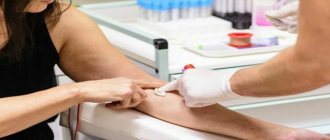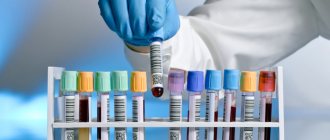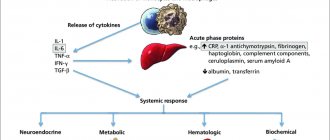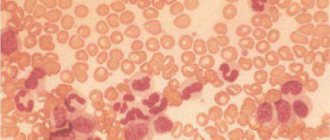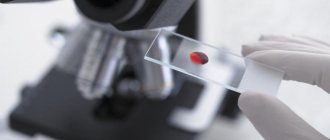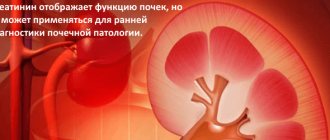Published: 05/29/2018 at 11:04
Category: Health
Tags: health
Often in medical practice, when conducting a laboratory examination, a biochemical blood test is prescribed, one of the indicators of which is rheumatoid factor. Its titers make it possible to determine not only pathologies of the locomotor system, but also the general health of the body, as well as identify dysfunctions of various systems and internal organs.
An elevated rheumatoid factor in the blood is detected. Based on the test results, the presence of pathological processes in the body is established. To accurately diagnose the disease, in addition to the rheumatic factor, an additional set of laboratory and hardware examinations is prescribed.
If rheumatoid factor is elevated, it can be fatal. Since many pathologies, a symptom of which are its elevated titers, affect the cardiovascular system, which can cause sudden death. To stabilize the level of RF in the blood, it is necessary first of all to eliminate the reasons that provoked its increase.
What is rheumatoid factor
Rheumatoid factor is an autoantibody that is produced by the immune system. Autoantibodies cause autoimmune and inflammatory processes by mistakenly attacking the body's own tissues. Rheumatoid factor is synthesized by plasma cells of the synovial membrane of the joint, moves into the blood, where it also affects blood vessels and other synovial membranes.
SCHEME OF INFLAMMATION DEVELOPMENT IN RHEUMATOID SYNOVITIS AND PRODUCTION OF RHEUMATOID FACTOR BY PLASMA CELLS ()
This marker gets its name from its initial discovery in people with rheumatoid arthritis. Since then, it has become apparent that other diseases and health conditions can trigger its production.
Elevated levels of rheumatoid factor have also been found in people with other autoimmune diseases, chronic infections, cancer, liver disease, and parasites. [, ] In particular, increased values of rheumatoid factor are determined in people with: systemic lupus erythematosus, systemic scleroderma, sarcoidosis, dermatomyositis, Sjogren's syndrome, septic endocarditis, infectious mononucleosis, tuberculosis, leprosy, viral hepatitis in the active phase, malaria, leishmaniasis, trypanosomiasis, Waldenström's macroglobulinemia, chronic lymphocytic leukemia, malignant neoplasms, etc.
Rheumatoid factor is a curious autoantibody that attacks other antibodies. It mainly takes the form of an IgM antibody (the largest antibody). Rheumatoid factor can alternatively exist as other types of antibodies (IgG, IgA, IgE, or IgD), but the IgM form is usually the first to appear in the blood and is more closely related to disease activity. [, , ]
SCHEME OF INFLAMMATION AND PRODUCTION OF RHEUMATOID FACTOR IN RHEUMATOID ARTHRITIS
Healthy people can also produce some forms of rheumatoid factors , which is our body's normal defense against bacterial toxins (lipopolysaccharides) and viruses, such as the Epstein-Barr virus . They do not attack the body's own tissues, but instead help fight infections and clear the body of immune cells that are no longer needed. Once the threat ends, their levels naturally drop. [, , ]
But in people with rheumatoid arthritis, this rheumatoid factor remains at elevated levels for longer periods of time. It probably doesn't directly cause the disease, but it does worsen symptoms by increasing inflammation and destroying joints. [, ]
Rheumatoid factor testing is primarily used to help diagnose rheumatoid arthritis and determine how advanced the disease is. Levels of this autoantibody often rise for many years before symptoms appear and may remain high long after treatment. However, rheumatoid factor is not considered the exclusive criterion for determining rheumatoid arthritis; there are a sufficient number of people with rheumatoid arthritis in whom this autoantibody is never detected. [, , ]
Indications for analysis
Having figured out what rheumatoid factor shows, it becomes obvious that in a biochemical analysis the concentration of IgM immunoglobulins is checked not only when joint pathologies are suspected. Other indications for testing include:
- the presence of symptoms indicating the development of rheumatoid arthritis (redness of the joints, pain when flexing and extending, severe swelling, feeling of stiffness in the morning);
- assessment of the effectiveness of the prescribed treatment regimen for rheumatoid arthritis;
- suspected connective tissue pathology;
- suspicion of the presence of cardiovascular diseases such as rheumatic endocarditis and pericarditis;
- appearance of signs of Sjögren's syndrome. With this disease, connective tissues are affected. If left untreated, the syndrome quickly becomes chronic, after which damage to various glands begins;
- diagnosing autoimmune diseases.
In addition to bone, joint and autoimmune pathologies, testing may be prescribed when diagnosing the following diseases:
- syphilis;
- pulmonary tuberculosis;
- cirrhosis of the liver;
- pulmonary sarcoidosis;
- systemic lupus erythematosus.
A blood test for rheumatoid factor is almost never performed as a stand-alone test. Most often it is prescribed together with a general blood and urine test, biochemical examination and ESR (erythrocyte sedimentation rate). If necessary, the patient may be prescribed other additional tests.
The number and types of tests are determined by the doctor depending on the suspected diagnosis.
Rheumatoid factor test
Your doctor will routinely order a rheumatoid factor test if you show symptoms of rheumatoid arthritis, such as [, ]:
- Joint pain, tenderness, redness and swelling
- Joint stiffness
- General fatigue and weakness
- Slight increase in temperature
- Dry eyes or mouth
Together with this test, they often also test for antibodies to cyclic citrulline-containing peptide (ACCP), which together makes it possible to very accurately diagnose rheumatoid arthritis. []
Norm of rheumatic factor in the blood
Qualitative and quantitative tests are used to determine the level of rheumatoid factor in the blood. The analysis is carried out by ELISA, latex test. RF is measured in IU/ml. A normal level of rheumatoid factor is considered to be less than 10 IU/ml.
A negative test for rheumatoid factor is a value of less than 10 IU/ml. But this does not always mean that a person is absolutely healthy. Up to 20% of patients with rheumatoid arthritis do not have elevated RF values.
Rheumatoid factor in men and women
In adult men and women, the rheumatic factor can be increased to 14 IU/ml.
The indicator undergoes some changes according to age.
By the age of 70, the normal value reaches 25-30 IU/ml.
Rheumatic factor in children
The normal level of rheumatoid factor in children is up to 12.5 IU/ml.
In a newborn child, the value does not exceed 8 IU/ml.
Normal rheumatoid factor levels
The normal level for rheumatoid factor varies depending on the reagents used in different laboratories, but generally the normal value should be less than <14 IU/mL (or <20 IU/mL, depending on the laboratory). [,,]
If you believe your rheumatoid factor levels are elevated, tests for certain diseases or conditions may show false readings.
Rheumatoid factor may interfere with the following laboratory tests:
- Malaria (false positive) []
- HIV (false positive) []
- Hepatitis C (false positive) []
- Antibodies to cardiolipin (false positive) []
- Thyroid-stimulating hormone (falsely increased) [, , ]
- Cytokines including IL-1-beta, IL-4, IL-6 and IL-8 (falsely elevated). [ ]
Causes of elevated rheumatoid factor
Rheumatoid arthritis
Rheumatoid arthritis (RA) is the most common systemic autoimmune disease that causes inflammation and destruction of the joints.
About 70-90% of people with rheumatoid arthritis have rheumatoid factors , which can further stimulate inflammation and damage to body tissue. Patients who test positive for rheumatoid factor show a more intense inflammatory response and worse disease prognosis than those people who do not have these autoantibodies. [,,,]
Higher levels of rheumatoid factor (>50 IU/ml) at the onset of RA disease are also associated with worse prognosis and severe arthritis. [, ]
Reducing this marker may play a positive role in the successful treatment of rheumatoid arthritis . Reducing rheumatoid factor levels has been shown to improve drug response in people with RA. []
NEGATIVE EFFECT OF INFLAMMATORY CYTOKINE IL-6 ON VARIOUS ORGANS IN RHEUMATOID ARTHRITIS ()
Other forms of arthritis
Rheumatoid factor levels may also be elevated in other forms of arthritis, although less likely than in RA.
Psoriatic arthritis occurs in people with psoriasis and rheumatoid factor is found in 15% of patients. []
Juvenile idiopathic arthritis is a form of autoimmune arthritis that occurs in children under 16 years of age. Its cause is still unknown, while rheumatoid factor is found in 5% of children with this disease. []
Other diseases and health conditions
High levels of rheumatoid factor are also found in a variety of diseases and conditions, including [R]
- Sjogren's syndrome is an autoimmune disease that causes dry mouth and eyes (rheumatoid factor is found in 75-95% of cases)
- Primary biliary cirrhosis, an autoimmune disease that destroys the bile ducts (45-70%)
- Mixed connective tissue disease – an autoimmune disease similar to lupus (50-60%)
- Viral infections, including hepatitis, HIV, Epstein-Barr , cytomegalovirus (10-76%)
- Breast cancer (13-47%) []
- Liver cirrhosis, liver fibrosis (25%)
- Lupus erythematosus is an autoimmune disease that damages connective tissue (15-35%)
- Sarcoidosis is an inflammatory disease that damages the lungs and lymph glands (5-30%)
- Parasitic infections such as malaria and toxoplasmosis (10-18%)
- Bacterial infections, including chlamydia, syphilis and tuberculosis (8-15%)
Lifestyle factors
Smoking
Smoking is the strongest environmental risk factor for the development of rheumatoid arthritis. [,]
An observational study of 296 people found that 88% of smokers tested positive for rheumatoid factor within 10 years. There were also more smokers in the rheumatoid-positive group than in the rheumatoid-negative group. []
The risk of elevated rheumatoid factor levels was 4 times higher in smokers than in people who had never smoked (observational study of 7,100 people). Another study of 100 patients with rheumatoid arthritis found a 2-fold increase in rheumatoid factor in former and current smokers compared to those who had never smoked. [, ]
Smoking approximately 1 pack (20 cigarettes) per day for 25 years leads to a 3-fold increase in the risk of high rheumatoid factor (study of 336 patients with rheumatoid arthritis). Moreover, rheumatoid factor levels were directly related to the number of years of smoking. The longer a person smoked, the higher the level of rheumatoid factor (2 studies with a total of 673 people with rheumatoid arthritis). [ , , ]
A lot of coffee
The number of cups of coffee consumed daily was directly associated with the risk of developing rheumatoid arthritis (RA) and positive rheumatoid factor testing in an observational study of 19,000 people. who drank 4 or more cups of coffee per day had more than twice the risk of developing rheumatoid arthritis and increased rheumatoid factor levels compared to people who drank less coffee. []
Aging
Rheumatoid factors are found at elevated levels more often in older adults (10-25% of all older participants) than in younger adults (5% of younger participants), as aging can cause a gradual imbalance of the immune system. [, , ]
OBESITY INCREASES THE RISK OF RHEUMATOID ARTHRITIS, INCREASES INFLAMMATION AND SEVERITY OF THE DISEASE ()
Rheumatoid factor: norm in women by age, table of indicators
( 3 3.33 out of 5)
This indicator indicates the total number of autoantibodies penetrating into the blood from damaged vascular tissues. If the test results reveal a high level, this indicates active damage to the vascular walls.
Rheumatoid factor is also considered as a foreign protein. To which the body produces an immune response.
This indicator increases with age and the majority of patients with positive rheumatoid factor are elderly people. This indicates that joint disease is developing in the human body. Most often, women suffer from such manifestations.
Basic steps before diagnostics
To avoid false positive test results, you must adhere to certain rules. If the diagnosis is carried out incorrectly, then treatment will be prescribed accordingly. Which will lead to deterioration in human health.
Basic Rules:
- Diagnosis is carried out on an empty stomach
- Only purified water is used for drinking. But before taking blood, this too must be excluded.
- Alcoholic drinks and cigarettes must be avoided for 24 hours.
- The day before the analysis, you should not engage in sports or other types of vigorous physical activity.
- Eliminate fatty and other unhealthy foods from your diet.
Blood sampling is carried out in the laboratory by a specialist. The required volume is drawn from the ulnar vein with a syringe. In addition to this diagnosis, additional tests may be prescribed to identify the full picture of the disease.
After the doctor receives the test results, he prescribes treatment. It is carried out individually for each case.
Normal RF indicators for women
After we find out what this indicator means, let’s consider the following: rheumatoid factor is the norm in women by age. A table with these indicators is given below.
| Woman's age | Indicator level, U/ml |
| Under 18 years old | 12 |
| Up to 50 years | 12,5-14 |
| Over 50 years old | 10 |
Small deviations from the norm should not cause concern. Experts believe that exceeding the norm several times is a cause for concern . There is a certain scale by which the degree of excess of the indicator is determined:
- Minor deviation – 25-59 IU/ml
- Significant excess – 50-100 IU/ml
- Severe deviation – over 100 IU/ml
A short-term hanging of the Russian Federation may also be observed, which returns to normal on its own. Similar manifestations are observed in women who have just given birth and in those who have undergone surgery.
An increase in the indicator in patients whose age exceeds 60 years is considered physiologically normal.
In addition, contraceptives, anticonvulsants and Methyldop cause an increase in the P factor.
But this is not always the reason, and high indicators may indicate the presence of a serious pathology.
Rheumatoid arthritis, its types
A disease such as rheumatoid arthritis cannot be cured. This type of diagnosis can determine it at the initial stages of formation. To obtain the most reliable results, it is necessary to carry out additional diagnostics.
- Felty's syndrome - this pathology is not common. This is a subtype of rheumatoid arthritis. The course of the disease passes immediately in a sharp form. A general blood test indicates leukopenia, and the RF increases several times.
- Sjögren's syndrome - with this pathology, connective tissues and internal secretory glands suffer. Symptoms of the disease include dry mucous membranes, damage to the respiratory system and kidneys.
Sometimes it happens that the rheumatoid factor remains normal, but the main symptoms of the disease are present. This may indicate the development of the first stage of the disease. For this, an additional immunological test is prescribed, which will clarify the situation.
Even slight increases in the indicator should be taken very seriously, because this may be confirmation of the development of rheumatoid arthritis.
If the patient has a tendency to diseases of an immune nature, then prophylaxis should be carried out several times a year and at the same time a blood test should be carried out, which will confirm the patient’s condition.
Other factors that lead to increased RF
Even if a blood test indicated the absence of RF, this is not reliable confirmation.
Similar anomalies can occur in a woman’s body during infectious diseases or acute inflammatory processes; this can provoke the development of connective tissue diseases.
Not only rheumatoid arthritis can cause an increase in the rate. This can lead to:
- Acute inflammation - ARVI, viral hepatitis and the like.
- Chronic inflammation of the liver, respiratory system, bones, muscles and kidneys.
- Autoimmune pathologies that lead to damage to the glands and connective tissues. In this case, the patient feels dry mucous membranes, poor functioning of the respiratory system, heart, blood vessels and kidneys.
- Leukopenia
- High white blood cell count
- Compaction and ossification of connective tissues
- A large amount of globulins in the blood serum
- Myeloma
- Lupus
- Systemic inflammatory lung diseases
- Surgery
- Oncology
Inflammatory processes in connective tissues affecting muscles. Such patients experience deterioration in movements, pathology of the skin, blood vessels and other organs.
There are a lot of diseases that can increase the level in the blood and they are all very dangerous for the body. Therefore, treatment must be carried out in a timely manner. It will help prevent complications.
The entire diagnostic and therapeutic range of procedures should be prescribed exclusively by a specialist; self-medication will not help in this situation . Only a doctor can assess your general health, age, medications taken and the presence of related diseases.
Combine all these factors, establish an accurate diagnosis and carry out treatment.
: Diagnostics of rheumatoid factor, method of working with Serodia RA:
Source: https://sosudask.ru/revmatoidnyj-faktor-norma-u-zhenshhin-po-vozrastu-tablitsa/
Health effects of high rheumatoid factor levels
Risk of rheumatoid arthritis
One observational study that followed 9,700 healthy people for 30 years found that slightly elevated levels of rheumatoid factor (25-50 IU/ml) were associated with an almost 4-fold increase in the risk of developing rheumatoid arthritis (RA). Very high levels (>100 IU/mL) were associated with a 26-fold increased risk compared with normal levels (up to 25 IU/mL). []
Risk of deep vein thrombosis
Rheumatoid factor levels above 110 IU/mL were associated with a 3-fold increased risk of blood clots in the deep veins (deep vein thrombosis) in an observational study of 670 people. []
Risk of atherosclerosis
One observational study of 6,500 people found that rheumatoid factor levels exceeding 15 IU/mL resulted in an increased risk of atherosclerosis in African-American women. []
PROLONGED INFLAMMATION IN RHEUMATOID ARTHRITIS LEADS TO: DEVELOPMENT OF METABOLIC SYNDROME (INCREASED INSULIN RESISTANCE), OSTEOPOROSIS, CARDIOVASCULAR DISEASES ()
Poor recovery after stroke
Rheumatoid factor levels within the normal range (above 7.6 IU/mL) were associated with a 79% increased risk of brain dysfunction compared with barely detectable levels (below 1.1 IU/mL) in a study of 582 patients with stroke. []
Risk of Cardiovascular Diseases
Men with rheumatoid factor levels above 6 IU/mL had a 2.9-fold increased risk of developing heart disease compared with men with levels below 6 IU/mL in a study of 1,100 healthy people. This association was not observed in women. []
Death from heart disease, cancer or any other cause
Negative rheumatoid factor test results were associated with a lower risk of death. In one observational study of 12 patients, positive (positive) rheumatoid factor demonstrated a 31% increased risk of death from any cause. Detectable levels of RF were also associated with a 45% increased risk of death from heart disease. []
In another study of nearly 300,000 people, RF levels greater than 20 IU/mL were associated with a 50% increased risk of death from any cause and a 56% increased risk of death from cancer . []
Another observational study (25 years) of 2,900 patients with rheumatoid arthritis showed an increase in these effects. Those people who tested positive for rheumatoid factor had almost twice the risk of premature death than those who tested negative for rheumatoid factor. []
TEMPORARY RELATIONSHIP BETWEEN THE PRODUCTION OF THE HORMONE CORTISOL AND INCREASE OR DECREASE IN ACTIVITY OF RHEUMATOID ARTHRITIS ()
Ways to reduce rheumatoid factor
Quit smoking
Smoking is directly associated with an increased risk of elevated rheumatoid factors and the development of rheumatoid arthritis . [R, R, , , , , , ]
If you are a smoker and have high levels of rheumatoid factor (or a family history of autoimmune diseases such as rheumatoid arthritis), it is imperative that you stop smoking, which can help reduce your risk of poor health and the development of autoimmune diseases.
Reduce coffee consumption
If you're an avid coffee drinker, gradually reducing the amount of coffee you drink each day, or avoiding coffee altogether, can help lower your rheumatoid factor levels and reduce your risk of rheumatoid arthritis.
Vegetarian diet
A study of 53 people found that following a vegetarian diet for one year resulted in a greater reduction in rheumatoid factor levels than an omnivorous diet. []
Yoga
One week of yoga practice led to 8% reduction in rheumatoid factor levels in a study of 64 patients with rheumatoid arthritis. []
Fish oil and olive oil
A combination of fish oil and olive oil for 24 weeks reduced rheumatoid factor levels by 30% in a study of 43 people with rheumatoid arthritis. [ ]
Vitamin E
In a study of 50 people who took 600 mg of vitamin E (dl-α-tocopheryl acetate) per day for 6 weeks, rheumatoid factor levels decreased by 44%. []
Vitamin K1
Taking 10 mg per day of vitamin K1 for 8 weeks reduced rheumatoid factor levels by 16% in a study of 64 patients with rheumatoid arthritis. []
Curcumin
In a study of 12 patients with rheumatoid arthritis, taking 1000 mg of curcumin per day reduced rheumatoid factor levels over 90 days. If you choose to supplement with curcumin, then purchase bioactive forms that have better absorption in the intestines. []
Ashwagandha, ginger, boswellia, turmeric
An Ayurvedic combination of ashwagandha, ginger, boswellia and turmeric, when used by 165 patients with rheumatoid arthritis for 16 weeks, helped reduce rheumatoid factor levels along with reduced joint swelling. []
Andrographis
Andrographis is a popular herbal supplement often used in Southeast Asia to reduce pain, inflammation and fever in Traditional Chinese Medicine and Ayurveda. In a study of 60 people with rheumatoid arthritis, taking andrographis for 14 weeks reduced rheumatoid factor levels. []
Annual wormwood (Artemísia annua)
Artemisia annua extract reduced rheumatoid factor levels in 159 people with rheumatoid arthritis (clinical study). []
Thunder God Vine (Tripterygium wilfordii)
Tripterygium wilfordii is a plant used in traditional Chinese medicine as a remedy for various autoimmune and inflammatory diseases.
In a meta-analysis of 6 studies and a total of 643 participants in people with rheumatoid arthritis, this plant reduced rheumatoid factor levels. []
Some aqueous extracts of this plant can have a negative effect on intestinal function, stimulate the appearance of rashes, and reduce the number of white blood cells. Almost all of these negative effects can be avoided by using safer alcohol extracts and taking them in the correct dosage. [, ]
Pine pollen
Pine pollen extracts reduce rheumatoid factor levels and other markers of inflammation in mice with arthritis. []
Resveratrol
In arthritic rats, resveratrol reduced rheumatoid factor levels by 63%. []
Alginic acid (brown seaweed)
Alginic acid, found in brown, red and green seaweeds, reduced rheumatoid factor levels in rats with rheumatoid arthritis. []
Arisema rhizomatum
Arizema rhizome is a traditional Chinese medicine herb that is used to reduce pain and inflammation. It markedly reduced rheumatoid factor levels in a study of arthritic rats. []
